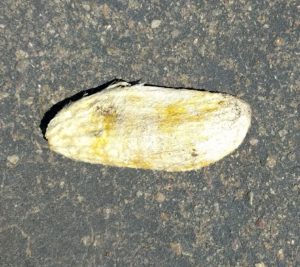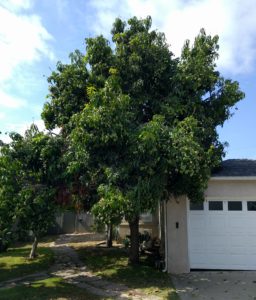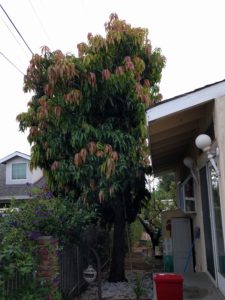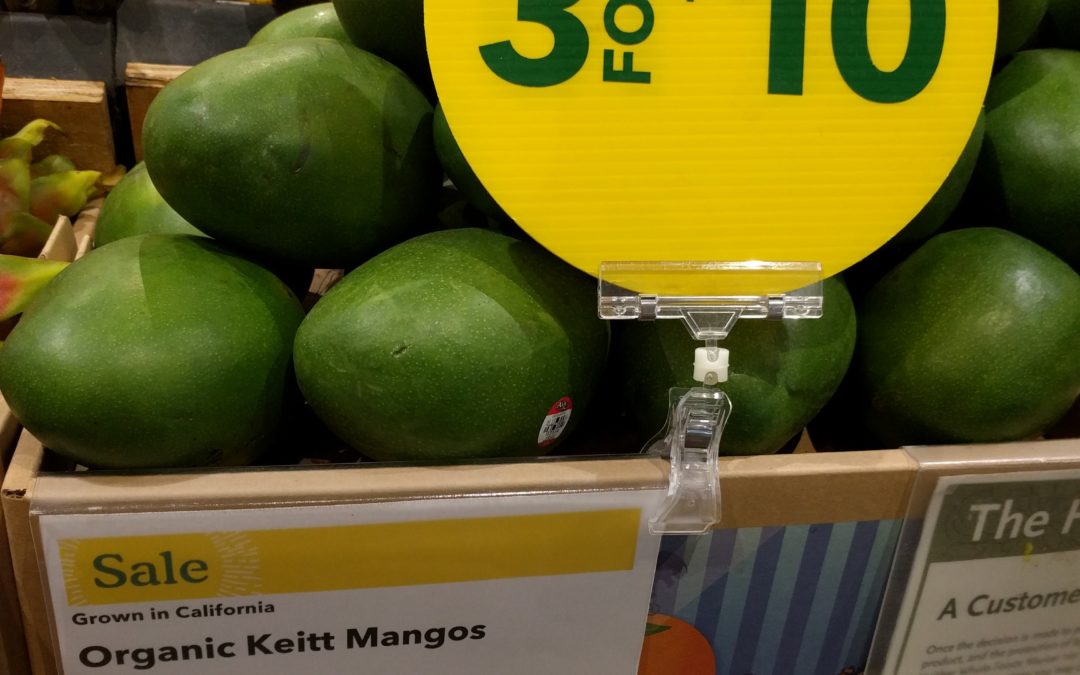We don’t normally shop at Whole Foods Market, but once each year I make a visit in order to buy these California-grown mangos. Last year, I bought some in October; this year I decided I’d stop by in September just to check and . . . I bought these three.

Should I choke at the price: 3 for $10? You can get Mexican mangos for $1 a piece, right? Yeah, well, these California mangos are bigger, for one thing. This year they’re actually not as big as those I bought last year. This is my son with one of last year’s (2016):

My sons go wild for mangos. They attack them like buzzards on a carcass. And due to the lack of fiber on these California Keitts, they were able to gnaw so much flesh off the seed the other day that it was this clean when they were finished:

The Keitt variety originated in Florida, but these mangos were grown in the desert of Southern California — an area called the Coachella Valley — not far from Palm Springs. I appreciate the Keitt variety in particular because they are delicious sweet or tart. I like my mangos sweet, so I let them soften and sweeten up before I eat them, but my wife likes her mangos tart, so she cuts the Keitts up while still firm. Either way, Keitt mangos almost always have a mostly green skin color. Whether soft or firm, sweet or tart, they rarely get as orange, pink, red, or yellow as some other mango varieties.
If you can’t get to the Whole Foods Market in Del Mar where I bought mine, where can you get some of these California Keitts? In the past, I’ve bought them at other Whole Foods Markets, as well as at Trader Joe’s. I do hear that they’re also available at the Santa Monica farmers market although I’ve never been. (Update: Sprouts has been stocking them in mid and late October, 2017, and for as low a price as $1.50 each.) The thing to keep in mind is that the season for these California Keitt mangos is now, so don’t bother looking for them much outside of September and October.
But wait, we can grow mangos in California? Indeed, they seem like an exotic fruit, but people in Southern California have been growing them for a very long time. A man named L.L. Bucklew was trialling dozens of mango varieties in Encinitas back in the 1930s, for example. (Read my post about the Bucklew mango trees here.)
The first large planting in the Coachella Valley was made in the 1980s. Here is a video about one of the mango farms, Wong Farms, in the Southern California desert.

But I’ve seen beautiful and fruit-laden mango trees of at least twenty feet in height (which suggests they’re decades old) in many parts of Southern California. The one in the photo above was in the yard of my neighbor in the Hillcrest part of San Diego. I’ve seen a beautiful mango tree in Tustin, Orange County. Some friends in Vista, North San Diego County, have multiple verdant and well-maintained old mango trees on their property and, I have to add, they’ve been kind enough to share a lot of delicious fruit with us over the years.

Once you get an eye for what a mango tree looks like, you might find yourself spotting them in yards in your neighborhood. I grew up in Los Angeles County, where this mango tree was growing in the side yard of a house across the street from my junior high school:

Only I had never “seen” it until this year. Today, I knocked on the door of the house to ask if I could take this picture. An elderly woman came to the door. “Sure, take a picture. Usually it has a lot of fruit. Big red ones — they’re really good — but this year it didn’t have many. We’ve already eaten them all.”
“Can I ask what variety it is, if you know. Or did you plant a seed?”
“We brought a mango back from Hawaii a long time ago and planted the seed.”
If you live in Southern California and you like eating mangos, then why not plant one in your yard too? I’ve got a couple of baby mango trees going in mine. Until they start bearing fruit, though, I’ll continue looking forward to this time of year when the Keitts from the California desert arrive in stores. I might also have to knock on that door by my junior high again next year, around August instead of September.
All of my Yard Posts are listed HERE




Thanks for this post, Greg! I’d sure love to have a mango tree!
I have this mango carp but I live in central Florida, it gives hundreds of mangos it about 25 years old. the problem that people have when there trees are not producing a lot of fruit is they need to fertilize the tree three times a year and looking at your picture it needs a good trim. especially on the top
I have many (20+) different varietys of Mango trees planted from seeds 10+ yrs.old, from Keit, Keith, Splendid, Amanda Panda, & other names etc.. all sweet & some non-fibrous. and some Manila mango varieties.
Some are xlnt, & some trees produce fibirous fruit that has little taste or is sour. Those I removed. I bought only two Manila grafted mango trees from a nursery, & they were both very fibrous. And I removed them also. I live in So Ca, & Mango trees grow very good here.. especially those planted from seed. They seem to.adapt to our climate perfectly. My question is.. the Mango trees with fibrous fruit, bearing 2yrs now. Is there anything to remedy this condition. If not, I will remove these trees. Appreciate your responses, thanks.
Hi Cyrus,
Cool to hear of your good results with so many mangos. If you know, I’d love to hear which trees are doing the best for you in terms of tree growth, fruit production, and fruit quality. Which varieties’ seeds were used for those? And which varieties (other than Manila) turned out not good?
If a mango tree is growing well but just produces fruit that is poor, I would graft it over to a better variety rather than remove it. (That rootstock is worth using, and the new graft on it will grow much faster than a new, little tree.) I don’t know of anything that can be done to significantly reduce the fibers in fruit from a given tree. From my experience, if a tree makes fibrous fruit, it always makes fibrous fruit.
Greg..thankyou for your response. Good idea to graft on to these fibrous fruit mango trees. I have one Keitt tree that has large sweet xlnt fruit. I definitely will graft from this Keitt, on to the fibrous trees. When is the best time to do grafts. My trees usually keep their leaves in the winter, & spring is most likely the best time. Should my grafts be low.. & should I cut back my doner trees to 1ft, to do the grafts. And they have at the most 1 1/2″ round trunks now.
Appreciate a response back. Thanks, Cyrus
Greg or anyone.. I also have a few Mango Trees grown by seed, & these trees bare lots of fruit.. some round & some oval (not Manila’s) that have a strong similar to kerosene smell, & taste to their fruit. I’ve waited till their 2nd time fruiting.. & its the same thing happening. Not fibrous, but this chemical type smell, & taste. Any thoughts related. Most likely, I will graft on to them, as they are about 15ft tall & vigorous growers (about 6yrs old) with lots of fruit. Your thoughts related, & is grafting best done in the Spring. And any suggestions with doing the grafts would be appreciated. 👍
Hi. I remember growing up in Florida with mango trees in the yard, and my mom saying that one of them was a turpentine mango. Google it… Interesting.
Instead of removing the fibrous trees. I would top work the tree with other varieties to it. Root is already established. Tropical Aces Farm sell mangos cuttings. They have over 300 varieties of mango trees and cuttings for sell.
Man ! Just found your site today and really think it’s amazing Greg .
I planted a few mango seeds a few weeks ago just to see what would happen. Now I have 3 baby trees. I am going to try to grow them in a pot for this winter and maybe put the in the ground next year after it warms up. How have your mango trees done since you wrote this post.
Hi Walter,
Over the past handful of years I have changed my approach to growing mangos. I had planted a few grafted trees, but I grew impatient with their insistence on flowering and trying to fruit. Grafted mangos immediately try to fruit even though their small canopies can’t support such fruit. Because they’re so insistent on flowering, they don’t grow much foliage.
This is in contrast to seedling mangos. So I’ve pulled out the grafted trees and grown a few mangos from seed. They’re far more vigorous and tough than the grafted trees. That being said, mine are still small.
I plan to start grafting one or two of them once they’re about chest height.
That’s the plan. We’ll see. My first round of seedlings a couple years ago got uprooted by my chickens when only knee high. Now I’ve caged these new ones.
look at me trying to lecture you on something you obviously already knew lol… (check my other post)
Greg,
Regarding everything you are growing out there in Romana, what do you do about gophers.
I am getting ready to plant my mango trees and avocado trees at our new house in Vista.
I want to protect them when I finally put them in the ground.
I have used chicken wire netting in the past with some success.
Also some of the avocado trees have black on the branches.
If I can I send you a pic that would be great
Hi Eddie,
I don’t use cages for my trees; I use Cinch Traps for gophers in my yard. I have gotten great control over the gophers through learning to use this trap. Check out this post: “The best gopher trap: it’s a Cinch.”
Usually, black on an avocado branch is from sunburn. Is it on a horizontal or south- or west-facing part of branches?
I ordered my cinch trap!!
I moved my avocado trees to where I plan to put into the ground so I cant say which direction the branches with the black were facing but I will check on the older tree to see which direction.
South or west could mean sunburn?
Yes, usually branches on the south and west sides of the canopy, or the south- or west-facing sides of any individual branch, gets the most sunburn.
Eddie… my dog controls any gophers (huskie/pitbull mix) and my 2 feral cats control mice, rats, & squirrels.
I learned to love mango while traveling in SE Asia over the years but was always disappointed with mangos in the US. Somewhere I heard mangos imported to the US were required to be steamed. I assumed this process killed the deep but subtle flavors I loved in Asian mangos. A couple years ago I tried the CA mangos at Whole Foods (in Idaho) and was amazed. Now I can hardly wait for September. Not all these mangos are perfect, maybe 1 in 4, but most all are are better than imported mangos. This year the CA mangos were available almost to Xmas.
Hi Rick,
Wow, I didn’t know they reached all the way up to Idaho. I noticed that the California Keitts were both late and small this year at the Whole Foods where I found them, but as usual the taste and texture was still excellent.
Greg. i want to see if you can help me. I am Looking for a Fruit punch Mango locally. Do you know a supplier in the Vista, san Marcos area? Thanks
I got mine at Exotica Fruit Tree nursery, guess where? Vista.
Don’t buy a discount tree or the last one on the lot like I did. Mine had anthracnose and I spent a year nursing it back to health and I’ve now planted it in a raised mound. I do updates on it from time to time click my icon.
Greg, how are your mangos doing? Are they getting any growth?
Hi Zen,
A cold night back in February wiped out my mangos, unfortunately.
that’s a crying shame, hope you aren’t going to give up would love to compare notes with you from time to time
maybe some manila seedlings? They seem to handle the soil pH and salts better and they aren’t grafted so a bit more robust. I’ve got one that I plan to graft on to at some point and it’s putting on a lot of new growth even if my fruit punch isn’t doing squat
Looking for a Hayden mango any idea where I can find it in s.cal?
Hi Wayne,
I would call Mimosa Nursery in L.A. They carry many mango varieties. I don’t recall seeing Hayden last time I was there but I wouldn’t be surprised if they have it.
https://www.mimosala.com/
You can try Louie’s in Riverside.
https://www.louiesnursery.com/plants/tropical-fruit-trees/mango-trees/haden-mango/
Question regarding the picture with title “Little mango and big mango. Hillcrest, San Diego, California”, I assume based the story is about 20ft tall. What is the size of the “little” one your guess?
I actually know little other than they are good. A corner of my backyard just opened up and I was looking to plant a not too big mango. I am in USDA Zone 10b, in NW Orange County, almost LA County. I am a senior person and cant reach to pick fruits if too tall and too lazy to clean rotten fruits on the ground. I called a few nurseries in the Anaheim area and have access to Keitt, Carrie, Ice Cream or Mallika in 5 to 7 G. I am inclined toward Keitt now enhanced by your story. What do you think? Thank you in advance
Hi Henry,
I’d guess that little mango is around 10 feet tall. You need not worry about a grafted mango tree growing rapidly too tall for you to reach. Here in Southern California, grafted mango trees flower and try to set fruit when they are only a couple feet tall and they essentially stunt themselves. The real challenge is in preventing them from setting fruit, or at least not too much fruit, when young so that they actually grow significant foliage.
Your general location sounds fine for growing a mango. I’ve seen some big and fruitful mango trees in your area.
I’d guess that you would be satisfied growing any of the varieties that you listed. You might want to read some more about them in the discussion of growing mangos in Southern California on the Tropical Fruit Forum: http://tropicalfruitforum.com/index.php?topic=23124.0
I’ve got my fruit punch in a raised mound and was giving it nothing but rain water while I could and now I fill a rain barrel with tap water and let it sit out for 2 days and pH it with citric acid (7.8 down to 6.5) and keep it oxygenated with aquarium stones and that’s what I water my avocado and mango trees with. My avocado made it out of shock and is growing like crazy, my mango isn’t doing a thing. I haven’t killed it yet at least so that’s good.
Wishing you and yours well Greg, I’ll have a poke around the blog haven’t been online in awhile.
I’m growing a keitt from seed, it’s over a year old now and the only seedling I’ve managed to keep alive. Germinated over 30 ataulfo seeds over the past 2 years and none survived past a few weeks. I really like the Keitt variety but you should try Ice Cream because it’s a good container mango that you can grow on your porch and it doesn’t get massive. I might get an Ice Cream myself.
I hope you still tend to this site! I have a mango tree given to us by a friend from Central America, so I have no idea what variety it is. Green, then starts to turn red. Every year it is a stand off between me and the rats/squirrels/possums. I never know when to harvest. The critters often beat me because the fruit seems so hard. I have some nice big ones (one looks to be a couple lbs.) So, I just found my first half mango on the ground, still hard, but half eaten. What should I do? Should I pick and hope they ripen inside, or chance it with the critters. They have been know to clear the tree pretty quickly.
Hi Julie,
I would pick. First, green mangos taste better than no mangos. Second, mangos can be picked mature but green (hard) and ripened off the tree, on the kitchen counter. In fact, every mango you find in stores was picked while it was still hard as a rock and then shipped a thousand miles to California. I wish you luck!
I you can buy netted wire fruit bags to cover your fruits so the animals can’t get to it
I’ve learned so much from your site, just found doing a search on ‘pruning mango trees in San Diego’. I planted a small mango tree about 8 years ago and I let it fruit (3-7 fruits/yr, rotted before ripening) when young and it seemed to stay about the same size until 2 years ago when it finally started growing and thriving (now 8′) which resulted in an amazing crop this year! I thinned the fruit by about 1/4 and harvested a couple dozen fabulous mangos which ripened almost all at once in October with the remaining few picked last week, all tree ripened. I am 2 miles inland in Del Mar.
Question: I would like to figure which variety it is. The mangos are the best tasting I have ever had, like eating homemade jam, so sweet, tangy and densely flavored. The ripened color is rich orange yellow with some red, the flesh is orange, the shape is more oval than flat (pit also) and the fruit is between 4-6 inches long. It is a little fibrous compared to the yellow manila kind from the grocery store (no fiber). Mature leaves are 12 inches long, bark is grayish and bumpy. Any ideas from this info? Thank you!
Hi Gail,
Great to hear that your tree has finally produced well. My guess would be that you have a Manila seedling mango tree, as these are commonly sold throughout Southern California, grown by La Verne Nursery.
Do an image search for “Manila mango” or “Ataulfo mango” and see if the fruit looks similar to yours, but don’t expect it to be identical since seedling trees produce fruit that are somewhat different.
I would be interested in details reguarding your overhead sprinkler setup: including on/off times,how you connect to your water supply.
I’m hoping to avoid high temp heat stress with avocado,lucuma&spodilla at my inland location in the San Fernando Valley
Hi David,
Have you seen this post? https://gregalder.com/yardposts/overhead-watering-for-evaporative-cooling-on-avocado-trees/
Let me know in the comments over there if you still have unanswered questions.
“A guy named L,L, Bucklew” was my grandfather, !880-1982.
He grew mangoes on a ten acre ranch in Encinitas ,which is partly still in the family.
One tree from 1943 is still producing good mangoes. It is called The Swami Tree and has quite an interesting history.
Bucklew had Early Gold and McPierson Improved, plus others . He wanted to develop a fruit with small seed, little fiber plus excellent taste. He was forever doing grafts.
The family still has all his tree records. Our mangoes ripen in November depending on weather.
For many years he had many a trail of mango lovers come to the ranch to buy fresh mango off the tree..
Amazing, Barbara! I’ve long been fascinated by your grandfather’s mango experiments and wondered what happened to his trees. Thank you for sharing.
Hi Greg,
Is it asking too much to grow a mango in Santa Cruz CA? I am a few miles from the ocean and on a hill that faces south. Usually doesn’t freeze here.
Hi Michele,
I think it’s worth a try.
There are many Mango trees growing here in Riverside county also. I am near Canyon Lake/Quail Valley. I have a Malika, nam doc mai #4 and nam doc mai #1. They have been in the ground about 2 years and have withstood the cold and heat, but they do get afternoon shade. As Greg said they do flower and try to produce fruit when young. I have been pruning the fruits for the past couple years to help the foliage grow. In looking forward to them being productive here soon.
Today I found the Wong Farms mangoes at Whole Foods in Hillcrest, San Diego.
3.99 each but they are huge
Thanks for the heads up, Jason. I was wondering aloud to a friend just yesterday about whether they had started picking yet. I look forward to getting some. $4 is totally worth it to me.
Turns out these mangos are from Corona College Heights (CCH) Citrus, not Wongs.
This company has 250 acres of Keitts in Coachella valley!
https://www.organicproducenetwork.com/organic-growers/organic-california-keitt-mangos-shipping-soon
Keith and some other large mangoes need a long warm/hot season to grow properly. Inland like Coachella the spot!
Powdery mildew and anthracnose definitely issues you will encounter hence grafting certain more resistant varieties. Then there is also the never ending debate on best rootstock for Socal….Manila or Turpentine?
Oh btw…you can get those massive Keitts at Stater Brothers also….sometimes on sale for 99c each.
My local nursery El Plantio in Escondido now sells grafted keitt trees in 5g containers. I’m about to go pick one up today. Long time no see Greg I’m back to starting to grow trees again after many failures 😕
Good news! And thanks for the heads up on the Keitt mango trees at El Plantio.
You didn’t mention the common SoCal problem of mildew or anthracnose destroying spring flowers. If you have something to share on that, please do. Khaled Hassan, whom I think yoiu know, has come up with an elaborate set of treatments to defeat those maladies, but most home growers will find them too laborious IMO. My Keitts usually do well inspite of some disease–but not this year. Valencia Pride and Lancetilla also seem less susceptible. Other varieties are more susceptible.